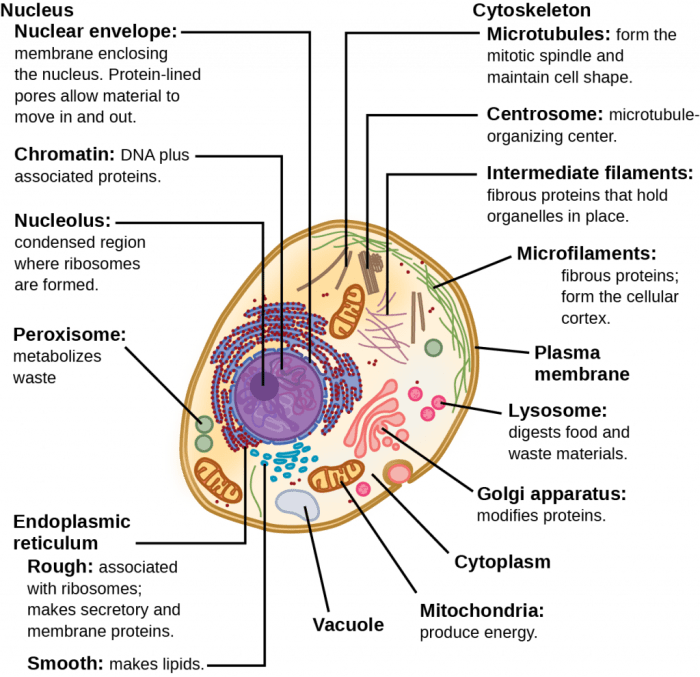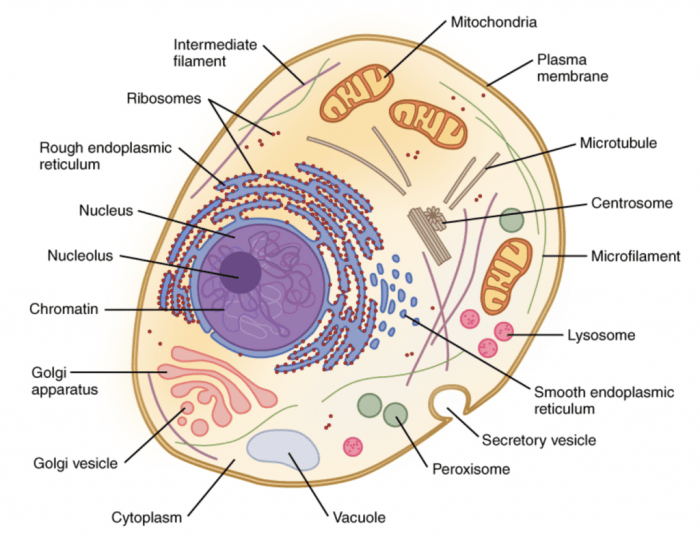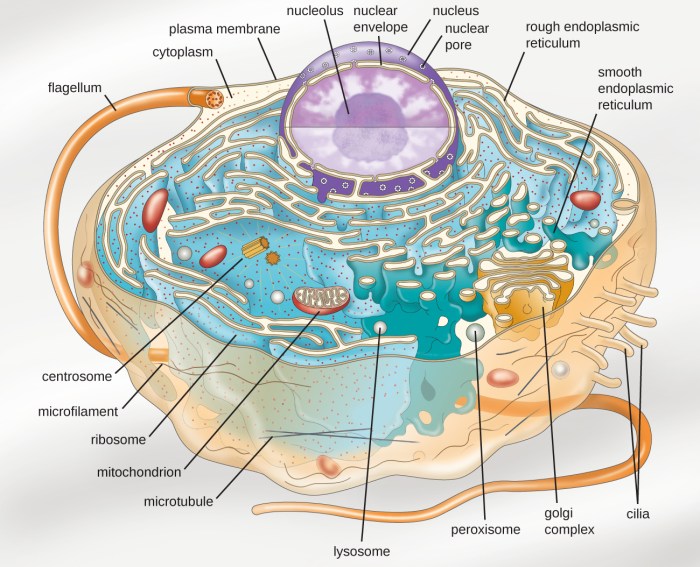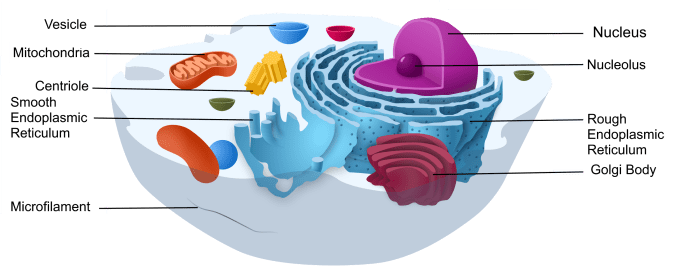Organelles in eukaryotic cells pogil – Delve into the fascinating realm of organelles in eukaryotic cells, the microscopic powerhouses that orchestrate the symphony of life. From the nucleus, the control center of the cell, to the mitochondria, the energy generators, this exploration unveils the intricate workings of these cellular components.
Unravel the secrets of organelle structure and function, witness their dynamic interactions, and trace their evolutionary journey from ancient origins to the diversity of life today. Prepare to be captivated as we embark on this scientific odyssey, unraveling the mysteries of the eukaryotic cell.
Organelle Structure and Function

Eukaryotic cells are complex and highly organized, containing a variety of organelles that perform specific functions essential for the cell’s survival and operation. These organelles are enclosed within membranes and have distinct structures and functions.
The Nucleus
The nucleus is the control center of the cell, containing the cell’s genetic material (DNA). It is surrounded by a double membrane called the nuclear envelope, which regulates the movement of materials into and out of the nucleus.
- The nucleus contains chromosomes, which are made up of DNA and proteins. DNA stores the genetic information that determines the cell’s characteristics and functions.
- The nucleus also contains the nucleolus, which is responsible for producing ribosomes, the organelles that synthesize proteins.
Endoplasmic Reticulum
The endoplasmic reticulum (ER) is a network of membranes that folds and transports proteins. It is divided into two types:
- Rough ER: Contains ribosomes on its surface, which synthesize proteins.
- Smooth ER: Does not contain ribosomes and is involved in lipid synthesis, detoxification, and calcium storage.
Golgi Apparatus
The Golgi apparatus is a stack of flattened membranes that modifies, sorts, and packages proteins synthesized by the ER.
- The Golgi apparatus modifies proteins by adding carbohydrates or lipids to them.
- It also sorts proteins into vesicles that are then transported to their final destinations within the cell or outside the cell.
Lysosomes
Lysosomes are membrane-bound organelles that contain digestive enzymes. They are responsible for breaking down and recycling waste materials within the cell.
- Lysosomes fuse with vesicles containing waste materials and digest the contents.
- They also play a role in cell death by breaking down the cell’s components.
Mitochondria
Mitochondria are the energy producers of the cell. They are double-membrane organelles that contain their own DNA.
- The inner membrane of mitochondria folds into cristae, which increase the surface area for energy production.
- Mitochondria produce ATP (adenosine triphosphate), the energy currency of the cell, through a process called oxidative phosphorylation.
Chloroplasts
Chloroplasts are found in plant cells and are responsible for photosynthesis, the process by which light energy is converted into chemical energy.
- Chloroplasts contain chlorophyll, a green pigment that absorbs light energy.
- They use the energy from light to convert carbon dioxide and water into glucose, a sugar molecule that the plant can use for energy.
Organelle Interactions: Organelles In Eukaryotic Cells Pogil

Organelles within eukaryotic cells do not operate in isolation; instead, they engage in intricate interactions that facilitate cellular processes and maintain homeostasis. These interactions are crucial for the efficient functioning of the cell and the organism as a whole.
Nucleus Interactions
The nucleus serves as the cell’s control center, housing the genetic material. It interacts with other organelles in several ways:
- Endoplasmic Reticulum (ER):The nuclear envelope, which encloses the nucleus, is continuous with the ER. This allows for the exchange of molecules between the nucleus and the ER, facilitating the transport of newly synthesized proteins into the ER for further processing.
- Golgi Apparatus:The Golgi apparatus modifies and packages proteins for secretion or storage. It receives proteins from the ER via vesicles, further modifying and sorting them before they are transported to their final destinations.
ER-Golgi Interactions
The ER and Golgi apparatus are closely associated, forming a functional unit known as the secretory pathway. This pathway is essential for protein synthesis and modification:
- Protein Synthesis:Ribosomes on the rough ER synthesize proteins, which are then folded and transported into the ER lumen. These proteins can then be modified within the ER.
- Protein Modification:The Golgi apparatus receives proteins from the ER via vesicles. It modifies these proteins by adding various functional groups, such as carbohydrates or lipids, and sorts them for secretion or storage.
Mitochondria-Chloroplast Interactions
Mitochondria are responsible for cellular respiration, generating energy in the form of ATP. Chloroplasts, found in plant cells, carry out photosynthesis, converting light energy into chemical energy. These organelles interact in several ways:
- Energy Production:Mitochondria produce ATP, which is used by chloroplasts for photosynthesis. In turn, chloroplasts generate oxygen and NADPH, which are utilized by mitochondria for cellular respiration.
- Metabolite Exchange:Mitochondria and chloroplasts exchange metabolites, such as pyruvate and malate, which are essential for both energy production and photosynthesis.
Organelle Evolution

Organelles are membrane-bound structures that perform specific functions within eukaryotic cells. The evolution of organelles is a complex process that has been shaped by both endosymbiosis and other evolutionary mechanisms.
The endosymbiotic theory proposes that organelles such as mitochondria and chloroplasts originated as free-living bacteria that were engulfed by a larger cell and eventually became integrated into the host cell’s metabolism. This theory is supported by several lines of evidence, including the presence of DNA in mitochondria and chloroplasts, the similarity of their ribosomes to bacterial ribosomes, and the fact that these organelles can divide independently of the host cell.
Implications of the Endosymbiotic Theory
The endosymbiotic theory has important implications for understanding the origin of eukaryotic cells. It suggests that eukaryotes evolved from a symbiotic relationship between two or more different types of cells. This theory also helps to explain the diversity of eukaryotic cells, as different eukaryotic lineages have evolved different sets of organelles based on their specific needs.
Evolution of Organelles Since the Endosymbiotic Event
Since the endosymbiotic event, organelles have continued to evolve and diversify. For example, mitochondria have evolved to become more efficient at generating energy, and chloroplasts have evolved to become more efficient at capturing light energy. In addition, new organelles have evolved, such as the peroxisome and the lysosome.
These changes have contributed to the increased complexity and diversity of eukaryotic cells.
Organelle Dysfunction

Organelle dysfunction is a major cause of cellular dysfunction and disease. When organelles are not functioning properly, they can disrupt cellular homeostasis, leading to a variety of health problems.Organelle dysfunction can be caused by a variety of factors, including genetic defects, environmental toxins, and aging.
Genetic defects can lead to the production of nonfunctional proteins, which can disrupt the function of organelles. Environmental toxins can damage organelles directly or indirectly, by interfering with their metabolism. Aging can also lead to organelle dysfunction, as organelles accumulate damage over time.The
consequences of organelle dysfunction can vary depending on the affected organelle. For example, mitochondrial dysfunction can lead to energy production problems, which can cause a variety of symptoms, including fatigue, muscle weakness, and cognitive impairment. Lysosomal dysfunction can lead to the accumulation of waste products in cells, which can cause a variety of diseases, including lysosomal storage diseases.
Mitochondrial Dysfunction, Organelles in eukaryotic cells pogil
Mitochondria are responsible for producing energy for the cell. Mitochondrial dysfunction can lead to a variety of diseases, including:
-
-*Mitochondrial encephalopathy
A group of disorders that affect the brain and nervous system.
-*Mitochondrial myopathy
A group of disorders that affect the muscles.
-*Mitochondrial cardiomyopathy
A group of disorders that affect the heart.
Mitochondrial dysfunction has also been linked to aging and neurodegenerative diseases. As we age, our mitochondria become less efficient at producing energy. This can lead to a decline in cognitive function and an increased risk of neurodegenerative diseases, such as Alzheimer’s disease and Parkinson’s disease.
Lysosomal Dysfunction
Lysosomes are responsible for digesting and recycling waste products in the cell. Lysosomal dysfunction can lead to a variety of diseases, including:
-
-*Lysosomal storage diseases
A group of disorders that are caused by a deficiency of lysosomal enzymes.
-*Gaucher disease
A lysosomal storage disease that affects the spleen, liver, and bone marrow.
-*Niemann-Pick disease
A lysosomal storage disease that affects the brain, liver, and spleen.
Lysosomal dysfunction can also lead to cell death. When lysosomes are not functioning properly, they can accumulate waste products in the cell, which can damage the cell and eventually lead to its death.
General Inquiries
What are the main types of organelles found in eukaryotic cells?
The main types of organelles in eukaryotic cells include the nucleus, endoplasmic reticulum, Golgi apparatus, mitochondria, chloroplasts, and lysosomes.
What is the role of the nucleus in eukaryotic cells?
The nucleus serves as the control center of the cell, housing the genetic material and regulating cellular activities.
How do mitochondria contribute to energy production?
Mitochondria are the primary energy generators of the cell, producing ATP through cellular respiration.
What is the significance of the endosymbiotic theory in understanding organelle evolution?
The endosymbiotic theory proposes that mitochondria and chloroplasts originated as free-living bacteria that were engulfed by eukaryotic cells, forming a symbiotic relationship.